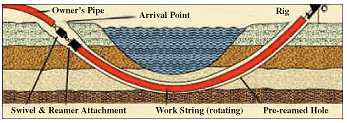Rich Maxwell mentions some things to do that makes HDD more successful when directionally drilling in sand.

For the past few months, I have been in places like Tampa, Tallahassee, Jacksonville, Orlando and Pensacola, Fla. Guess what they all have in common? SAND. I have been up to my eyeballs in it. You talk about a specific application for horizontal directional drilling that has matured in the past few years. Drilling in sand has come a long way. I remember five years ago contractors were getting stuck in sand every day. Even on a pilot bore a guy could get 400 feet of drill pipe stuck. And the bad memory — in many cases, they ended up leaving the string. Drillers used to run from any drill pipe that had upset tool joints. But lest we forget, and for you readers who may not drill in sand that often, let me mention some things we have learned to do that make HDD more successful when directionally drilling in sand.
"The most important thing when you are drilling in sand is mixing your mud," Mike Harford of Wiring Technologies, Altamonte Springs, Fla., says. "I mix two 1/4 bags of bentonite to 300 gallons of fresh water. I like it to look almost like putty," explains Hartford and others who recommend a proper mixture of bentonite when you are installing product in sand. (Literature suggests 55 to 65 second mud.) HDD contractors may report, "I might have used 40 bags of bentonite last month drilling in clays. This week, I used over 40 bags in four days drilling in sand."
Click here for more tips on mixing and managing drilling fluids.
Bentonite does several critically important things. In sand, you are dealing with a very porous formation. Fluid loss is a major factor. Bentonite seals the hole, literally holding the drilling fluid in the borehole. When properly mixed with the spoils, it also creates slurry that suspends the material, creating a wall around the bore path. What you don't want is fluid loss, which weakens the formation, causing collapse.
Don't try to cut corners (costs). Contractors like Harford recommend you use the same viscosity on the pilot bore as you use during the pullback. If you fail to prepare a good pilot hole, it is likely that it will collapse around the drill pipe during pullback.
Harford also says, "We use a cutter reamer and a packer combination on the backream, but we are not cutting. You don't cut sand and pack it like in clays. You mix sand with bentonite." Crews can get themselves in big trouble trying to expand a hole in sand conditions. A packer often is used to compact the wall of the bore hole, but to get to the desired diameter, a large enough hole should be cut, not packed. For example, if you were pulling in a 6-inch pipe, you might cut the hole to 8 inches (or 10 inches if the bore were over 300 or 400 feet). Follow the cutter with a 6-inch packer with a swivel attached to the 6-inch product. Every contractor does it differently, but the point is, don't expect to compact sand.
While we're talking about tooling, it needs to be mentioned that hard-facing the drill head and other down hole tooling is highly recommended. Sand is very abrasive. If you don't apply some tungsten carbide flux at strategic leading points of the tool — especially the drill head assembly — you will see unbelievable abrasive wear to your tooling.
One common practice among contractors with mini- and mid-size HDD drill rig owners is pre-reaming. "For any bore over 100 to 120 feet and any installation over 4-inches, I recommend you pre-ream the hole," Harford comments. Pre-reaming is the technique of making a pass back through the pilot hole with the backreamer before attaching the swivel and product for the final pull/installation. In cases where the product is over 10 inches, you may even step-cut to the final diameter, making two passes first with, say, an 8-inch and then with, say, a 12-inch or 14-inch before the final pull. "The time you think you lose by pre-reaming you actually will make up because of the quicker pullback due to proper hole preparation not to mention the wear and tear on equipment," Harford says.
I also need to comment on the mud delivery system. Evaluate your pump with the manufacturer to make sure it is capable of sustained high viscosity mud. Some of the older models and some smaller drills cannot pump thick mud.
My best recommendation on the whole subject of drilling in sand is to contact a bentonite manufacturer and/or distributor for specific applications in your soil conditions. They will talk about pH of the water, gel strength, viscosity and polymer additives. I will leave those discussions up to the pros.


Report Abusive Comment